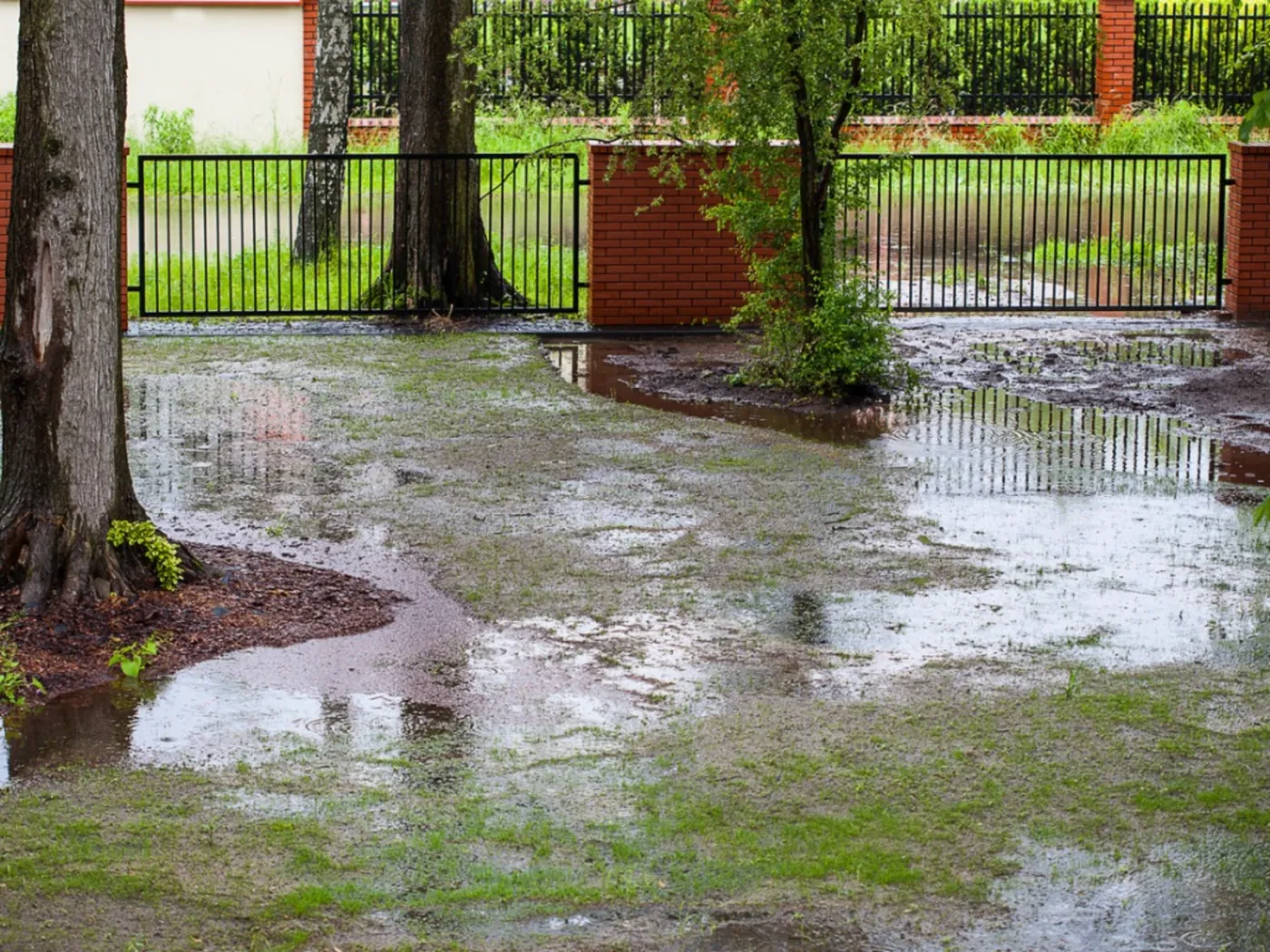Tired of the perennial soggy spots in your beautiful yard?
We get it.
Not only is it painfully hard to mow over the wet spots, but they are a complete eyesore. Not to mention the damage the wetness can cause to your property and your grass over time.
In this post, we talk about some of the common causes of landscape drainage issues and give you some advice on ways to fix these drainage issues to prevent your well-manicured lawn from turning into a swamp.
Common Causes Of Landscape Drainage Problems
Drainage problems are mainly a result of low spots or poor soil quality, leading to poor drainage. It’s actually more common than you’d think, to the ire of countless homeowners across the globe.
Low spots are usually caused by downspouts that are too short and end up draining into the landscaped area, walkways that block off water, yard slope or pitch that does not divert water away from the landscaped area, or impacted soil that retains water for far too long.
Drainage problems in a yard usually start off as wet spots and small muddy puddles which can turn into swamp-like areas all over the property. When it gets to that point, it’s a clear sign that your yard is retaining much more water than it should, and something needs to be done about it ASAP.
Solutions To Landscape Drainage Problems
Because landscape drainage problems result from different causes, they call for different solutions. Here are some of the most common DIY solutions:
Check Your Watering Schedule
Before launching into complex solutions, check your watering schedule. There is a possibility that you overwater your yard. Cut down on both the frequency and the amount of water. If the water spots drain off in the next week or two, you simply don’t have an extensive drainage problem.
If the trouble water spots are still there, then, by all means, proceed with the solutions below.
Extend A Downspout
Again, before you think of dramatic solutions like digging out a trench near your house or hiring a contractor to do regrading, start with a simple solution like extending the downspout to be long enough so that water flows away from your yard. This probably doesn’t seem like much of a fix, but it helps redirect water into a lower area of your yard or to an entirely different location outside your landscape.
Pay attention to the existing downspout inlets. They could be clogged with leaves, debris, and other obstructions.
Install A Creek Bed
Building creek beds in areas with poor grading can help move stormwater from low water spots to either a dry well or rain garden.
If done well, a creek bed will complement the rest of your landscape even when dry. Of course, you won't build a creek bed over the entire yard, but it should be big enough to control the surface water.
Line the creek bed with stones and gravel and add some plants or large rocks for better aesthetics.
A clever way is to channel the water into a small dry well so that the water can seep into the ground at its own pace.
Build A Rain Garden
Consider building a rain garden if your yard has no proper slope to drain off water from the low spot. A rain garden may not necessarily get rid of all the water in the low spots but it will most certainly be more aesthetically pleasing to the eye than the muddy holes full of nearly-floating turf.
A rain garden is usually filled with water-friendly plants like ferns and decorated with stones, river rock, and gravel.
The rain garden is a perfect ending point for a downspout or a creek bed.
Construct A Dry Well
A dry well is often constructed as an endpoint of a creek, downspout, swale drain, or even a french drain to collect water and slowly disperse it to the soil nearby. It is basically a hole fitted with either a drainage fabric, concrete basin, a weighted sleeve, or a large metal basin with holes in all its sides to allow water to drain out into the soil.
You can find a lot of DIY tutorials on building a simple dry well in your backyard.
The great thing about a dry well is that you can always increase its capacity by installing a larger tank. Gravel and other porous stones are usually added to control the amount of water being drained.
Install A French Drain System
A French drain is a long perforated drainage pipe that is buried underneath the soil to collect excess water and drain it away from the low spots. The drainage pipe is usually angled downward for improved drainage and then covered with gravel, rocks, and other porous material at the grade level so that it's not visible.
Installing a french drain is pretty easy. However, you'd need to dig a trench using heavy-duty landscaping equipment that is about two feet wide and six feet deep and then backfill the gravel.
Remember to use appropriate safety gear if you are operating heavy equipment and other digging tools.
Try out these fixes but if the problem persists, consider hiring a Gainesville landscape drainage professional to assess the full scope of the issue and design a customized corrective measure for your drainage issues.
----
Angelica Lovelock is the Content Manager at FortisHD. She loves to collaborate with industry experts and has written various articles around landscaping, heavy equipment, Gardening, and much more. In her free time, she enjoys riding everything from solo adventures in the mountains to big social night rides.


